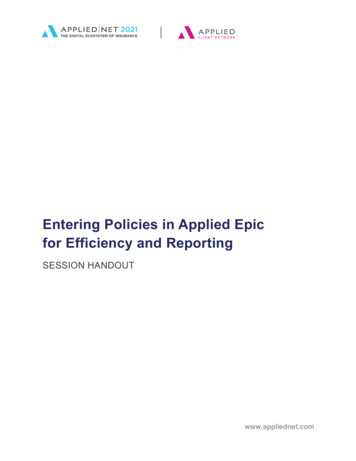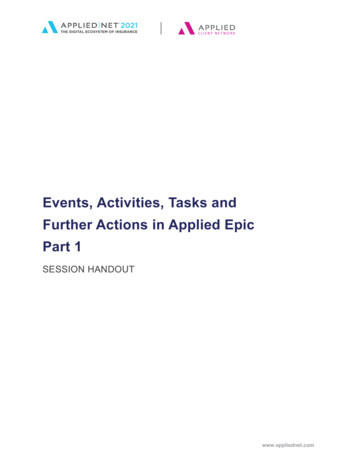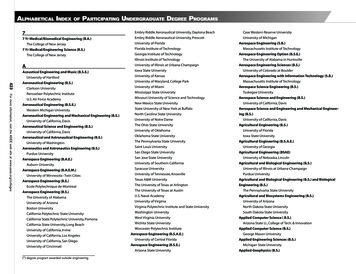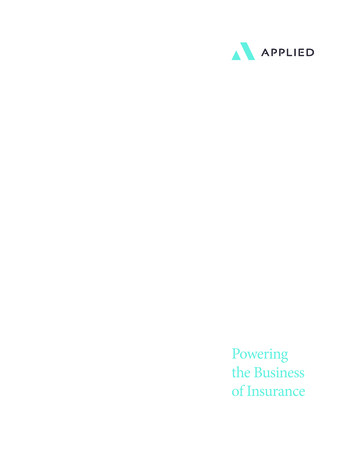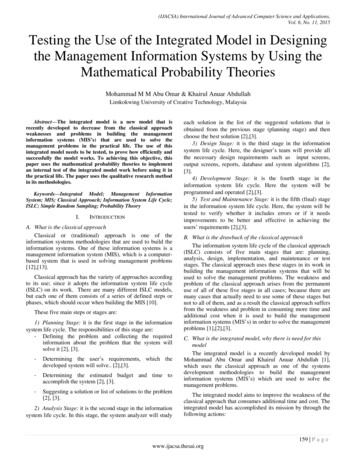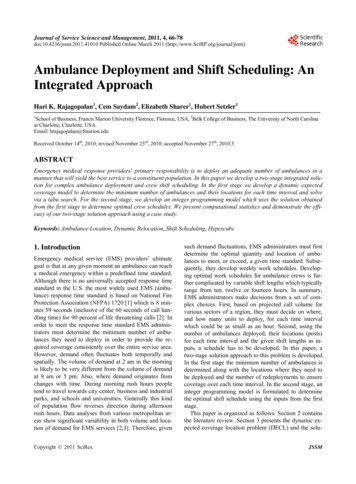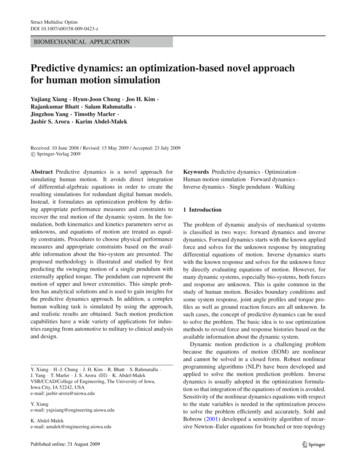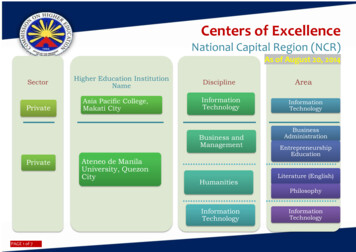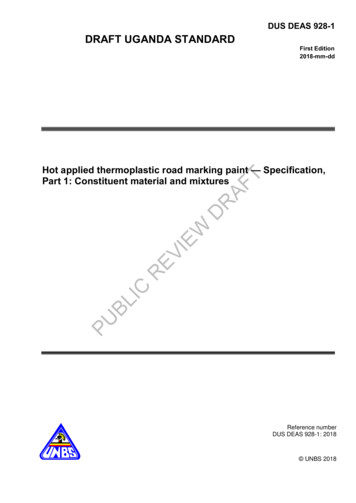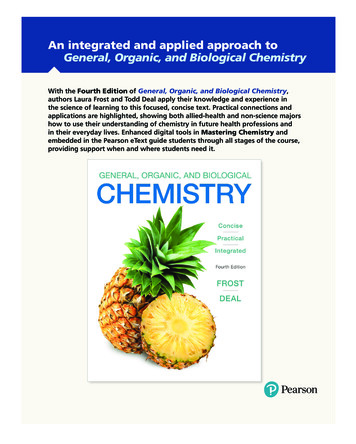
Transcription
An integrated and applied approach toGeneral, Organic, and Biological ChemistryWith the Fourth Edition of General, Organic, and Biological Chemistry,authors Laura Frost and Todd Deal apply their knowledge and experience inthe science of learning to this focused, concise text. Practical connections andapplications are highlighted, showing both allied-health and non-science majorshow to use their understanding of chemistry in future health professions andin their everyday lives. Enhanced digital tools in Mastering Chemistry andembedded in the Pearson eText guide students through all stages of the course,providing support when and where students need it.A02 FROS8696 04 SE WALK.indd 104/12/18 12:10 AM
Apply the science of learningto the way students learnUPDATED! Discovering the Conceptscan be used to engage students in groups duringclass as they construct an understanding of thecontent in cooperation with their peers.p. 189Guided Inquiry Activities, authored by LauraFrost, engage students with more of the topics in thetextbook through exploration, concept development,and application. These Activities are available in theMastering Instructor Resources.A02 FROS8696 04 SE WALK.indd 204/12/18 12:10 AM
Relate chemistry tostudents’ future careersEXPANDED! Topicsfocused on healthscience emphasize thatgood health and scienceliteracy are critical foreveryone and appearthroughout the text.Examples include two newIntegrating Chemistryfeatures covering commonviral diseases and glutensensitivity.p. 1483799.7 The Relationship Between pH, pKa, Drug Solubility, and DiffusionHealth-RelatedProblemsare integratedthroughout eachchapter and aretied to real-lifeapplications fromallied-health fields,helping to promotecritical thinking skillsand to connect thechemistry learnedwith their futureprofessions.Additionally,clinical examplesthroughout thetext pay particularattention to topicssuch as acid-base andbiochemistry.Practice Problems9.53 The antihypertensive medication alprenolol is shownas an acid below. The pKa for the acid is 9.6.a. Which form is charged: acid, conjugate base, orboth?b. Which form (acid, conjugate base, or both) willpredominate in a stomach with a pH between 1and 3?c. Which form, acid or conjugate base, will be ableto more easily diffuse through a cell membrane?OHHa. Will the acid or the conjugatebase predominate at the following pH values: 3.00, 4.85, and7.40?b. At each pH, is that formcharged or uncharged?OOHNNiacin, pKa 4.85c. Calculate the ratio of[c. base]/[acid] present at each pH.9.56 Consider the neurotransmitter dopamine, which hasa pKa value of 8.90. NO9.55 Consider the vitamin niacin, which has a pKa valueof 4.85.HAlprenolol, an antihypertensive,pKa 9.69.54 The anticonvulsant medication valproic acid isshown as an acid below. The pKa for the acid is 4.8.a. Which form is charged: acid, conjugate base, orboth?b. Which form (acid, conjugate base, or both) willpredominate in the first part of the small intestine (jejunum), where the pH is between 6 and 7?c. Which form, acid or conjugate base, will be ableto more easily diffuse through a cell membrane?OHa. Will the acid or the conjugate base predominate atthe following pH values: 7.45, 8.90, 13.40?b. At each pH, is that form charged or uncharged?c. Calculate the ratio of [c. base]/[acid] present ateach pH.HOHONH 3Dopamine, acid form, pKa 8.909.57 Procaine and lidocaine are used to numb the gumsduring dental procedures. Procaine has a pKa of 9.1,whereas lidocaine has a pKa of 7.9. Which do youthink will relieve pain faster in the gums? Explain.9.58 Both mepivacaine and bupivacaine are local anesthetics used in epidural blocks. Mepivacaine has a p. 379pKa of 7.6, whereas bupivacaine has a pKa of 8.1.Based on their pKa values, which will have more ofthe uncharged form available at physiological pH,thereby blocking pain quicker? Explain.Valproic acid, an anticonvulsant,pKa 4.8A02 FROS8696 04 SE WALK.indd 304/12/18 12:10 AM
Reach every student . . .EXPANDED! 11 newPracticing theConcepts videosexplain major conceptsthat students strugglewith in the chapter. Thevideos are 3–5 minuteslong and are narratedby author Todd Deal,with video assessmentquestions writtenfor use in LearningCatalytics, the PearsoneText, and assignable inMastering Chemistry.The ChemistryPrimer in MasteringChemistry helps studentsremediate their chemistrymath skills and preparefor their first collegechemistry course. Scaledto students’ needs,remediation is onlysuggested to studentsthat perform poorly onan initial assessment.Remediation includestutorials, wrong-answerspecific feedback, videoinstruction, and stepwisescaffolding to buildstudents’ abilities.A02 FROS8696 04 SE WALK.indd 404/12/18 12:10 AM
with Mastering ChemistryWith Learning Catalytics,you’ll hear from every studentwhen it matters most. You posea variety of questions that helpstudents recall ideas, applyconcepts, and develop criticalthinking skills. Your studentsrespond using their ownsmartphones, tablets, or laptops.You can monitor responses withreal-time analytics and find outwhat your students do—anddon’t—understand, to helpstudents stay motivated andengaged.ENHANCED! End-ofchapter questionswith answer-specificfeedback use datagathered from all ofthe students using theMastering Chemistryto offer wrong-answerfeedback that is specificto each student, whereand when they needit. Rather than simplyproviding feedback ofthe “right/wrong/tryagain” variety, Masteringguides students towardsthe correct final answerwithout giving theanswer away.A02 FROS8696 04 SE WALK.indd 504/12/18 12:10 AM
Give students anytime, anywhereaccess with Pearson eTextPearson eText is a simple-to-use, mobile-optimized, personalized readingexperience available within Mastering. It allows students to easily highlight, takenotes, and review key vocabulary all in one place—even when offline. Seamlesslyintegrated videos, rich media, and embedded interactives engage students and givethem access to the help they need, when they need it. Pearson eText is availablewithin Mastering when packaged with a new book, as an upgrade students canpurchase online, or can be adopted separately as your main course material.A02 FROS8696 04 SE WALK.indd 604/12/18 12:10 AM
Improve learning withDynamic Study ModulesDynamic Study Modules inMastering Chemistry helpstudents study effectively—andat their own pace—by keepingthem motivated and engaged. Theassignable modules rely on thelatest research in cognitive science,using methods—such as adaptivity,gamification, and intermittentrewards—to stimulate learning andimprove retention.Each module poses aseries of questions abouta course topic. Thesequestion sets adapt to eachstudent’s performanceand offer personalized,targeted feedback tohelp them master keyconcepts. With DynamicStudy Modules, studentsbuild the confidence theyneed to deepen theirunderstanding, participatemeaningfully, and performbetter—in and out of class.A02 FROS8696 04 SE WALK.indd 704/12/18 12:10 AM
Instructor support you can rely onGeneral, Organic, and Biological Chemistry includes instructor supportmaterials in the Instructor Resources area in Mastering Chemistry. Resources includecustomizable PowerPoint lecture presentations and all images in JPEG format.A02 FROS8696 04 SE WALK.indd 804/12/18 12:10 AM
PrefaceTo the StudentHow does the body regulate carbon dioxide levels? Why aresome pharmaceuticals injected and others taken orally? Thekey to understanding the answers to these questions starts withchemistry.General, Organic, and Biological Chemistry was writtenespecially for students interested in pursuing a health sciencecareer like nursing, nutrition, dental hygiene, or respiratorytherapy. Yet this textbook has applications for all studentsinterested in discovering the concepts of chemistry in everyday situations. Throughout the text, you will find that we haveintegrated the concepts of general, organic, and biologicalchemistry to create a seamless framework to help you relatechemistry to your life.One of our goals in writing this book is to help youbecome better problem solvers so that you can critically assesssituations at your workplace, in the news, and in your world. Inthis edition, we have kept the problem-solving strategies whileincreasing their depth to encourage greater understanding.As you explore the pages of this book, you will encountermaterials that apply chemistry to your life apply chemistry to health careers that interest you encourage you to develop problem-solving skills help you to work with and learn from your fellow students demonstrate how to be successful in this chemistrycourse and other courses.As you read this book, you will notice that the language isless formal. Wherever possible, we relate the chemical conceptsto objects in everyday life to help you understand chemistry.We also provide several study strategies with this edition,including materials for you to engage with before, during, andafter class. Cognitive research in learning tells us that newideas stick with us better if they are related to things that wealready know and if we practice retrieving this informationfrom our memories.New to This EditionThe Fourth Edition continues to strengthen our strategy ofintegrating concepts from general, organic, and biologicalchemistry to give students a focused introduction to the fundamental and relevant connections between chemistry andlife. With an emphasis on developing problem-solving skills,guiding the students’ reading through Inquiry Questions, andhelping students retain information through iterative retrievalpractice, this text empowers students to solve problems inapplied contexts relating to health and biochemistry. Each chapter now begins with a Learning Tip relevant tothe chapter content. As students acquire the LearningTips throughout the book, they can become more independent learners. The Learning Tips are rooted in thecognitive science literature and are supported with a listof references in the Credits section. While the order of chapters remains the same, some sections within the chapters have been reorganized for the better flow of concepts. In Chapter 1, we moved Section 1.6(How Matter Changes) up to follow Section 1.2, beforewe begin significant figures and unit conversion.Chapter 7 now begins with Gases and Gas Laws prior todiscussing attractive forces and the physical properties ofliquids and solids. This edition includes an increased number of problemsstamped with the health iconto highlight healthapplications of the chemistry content, making the bookmore relevant for students in the health professions. The biochemistry applications offer even more depththan the Third Edition, providing new content on drugsolubility and delivery, peptides in celiac disease, common viral diseases, and CRISPR. We created new Practicing the Concepts videos for thisedition. Each chapter now has two supporting videos.The videos, which run from 3 to 5 minutes, featureauthor Todd Deal. In the videos, he reviews a big idea orconcept from the chapter, then helps students deepentheir knowledge and develop their skills. Carefully developed visuals portray concepts vividly, and a pause-andpredict stopping point gives the student a chance for ameaningful concept check. Every chapter has been revised, including the sampleproblems and practice problems. To support areas ofchapters with expanded coverage, we added new practice problems.To the InstructorActively Engaging Your Studentswith Discovering the ConceptsFrom Laura FrostEach chapter in General, Organic, and Biological Chemistry contains at least two guided inquiry activities, called Discoveringthe Concepts, at the beginning of some sections. These activities are offered to engage students in groups during class asthey construct an understanding of the content in cooperationwith their peers. Active learning strategies that includeDiscovering the Concepts have been shown to increase engagement, learning, and retention (see Freeman et al., 2014). All theinformation necessary to answer the questions in the activity isincluded at the beginning of the activity, so students should notneed to use other parts of their textbook. An outline of somekey points regarding the use of these activities follows.xiiA01 FROS8696 04 SE FM.indd 1228/11/18 5:24 PM
PrefaceFacilitation Faculty can facilitate the use of these activitiesby managing class time, guiding students to the correctanswers instead of giving them the correct answers, and interjecting information during the group work where appropriateto guide student learning. It is also important for the instructorto be familiar with the activity in advance, to anticipate wherestudents might struggle with the questioning.Organizing Groups Faculty new to active learning oftenhave questions about organizing student groups: Should Iassign students to particular groups? Should I let students picktheir own groups? Should I rotate the groups during the term?Because this course is an introductory course with few (if any)prerequisites, random assignment on the first day of class cansuffice. However, I encourage diversification by gender, ethnicity, and problem-solving strategies whenever possible. Withfew exceptions, I have found that students become comfortable with their group members and almost insist on staying inthe same group. That being said, I have met many colleagueswho use active learning strategies who do rotate groups. Thistoo can be a successful approach, with the caveat that instructors must inform students of their intention to rotate groupswell in advance. Some faculty members rotate groups after anexam, some rotate them more frequently, and others keep thesame groups for the entire semester. More information ongroup work can be found in CBE Life Sciences EvidenceBased Teaching Guide on Group Work (Wilson et al., 2018).Skill Development Encourage students to review andextend their understanding by completing problems outside ofthe classroom. The practice problems at the end of each textbook section, and the additional problems and challenge problems at the end of the chapters, are ideal for this purpose.Group Accountability To develop skill in written communication, it is essential that a record be kept of the students’activities during the class period by a student acting as grouprecorder. Other roles such as group manager, presenter, andtechnician should also be considered to keep the groups ontask. An instructor may choose to grade some, all, or none ofthe activity, or assign participation points during the classperiod. However you choose to do it, group accountabilityshould be incorporated into your grading scheme in some form.Individual Accountability Some form of individual understanding of the activity should also be a part of the assessment.This can be done through quizzing, which also encourages skilldevelopment and retrieval practice. I give a short quiz at thebeginning of a class based on the activity from the previousclass. Quizzing can be done online, as a clicker quiz (works wellin large classes), or on paper. The quiz should be reviewedimmediately after students complete it, offering some teachablemoments for student understanding.To be efficient, the quizzing process should take no morethan 10 minutes of the class period. Quizzing also has theeffect of increasing student attendance and decreasing studenttardiness if done at the beginning of the class. Individualaccountability can also be assessed through monitoring homework, either online or on paper.A01 FROS8696 04 SE FM.indd 13xiiiMetacognition To bring their learning full circle, studentsmust reflect on their own learning. I provide groups with a feedback sheet that is to be completed at the end of class by one of themembers of the group. The purpose of this reporting is to havestudents assess what they did and did not learn during the classperiod. The wording can be general, or changed to reflect thecontents of the activity, but should provide the instructor withfeedback regarding the effectiveness of the activity. The followinggeneral items are suggested for inclusion in the feedback sheet: List the primary topic(s) that you learned during today’sactivity. Is there anything that is still not clear regarding today’sactivity? Please be specific.Many instructors are concerned with covering therequired material in a course, and wonder whether an activeclassroom will slow the pace of coverage. I offer two thoughtsrelated to this very real concern:1. Because the activities help students develop problemsolving and critical-thinking skills, students are better ableto apply the learned knowledge to related topics not explicitly taught in class. For example, identifying functionalgroups does not mean that the instructor must show thestudents all common functional groups in class (as may bedone in a lecture). Once the concept of organic familiesand functional groups is introduced, students should beable to use a table to identify other functional groups,thereby maximizing instructional time in the classroom.2. Just because a lecturer covers a topic in the classroomdoes not mean that a student learned it. In fact, facultymembers are regularly amazed at the lack of knowledgeretention from one course to the next.I invite you to try Discovering the Concepts. If you find thatthese activities are helpful in engaging and reaching students,you may want to explore the full set of activities atpearsoncustomlibrary.com for use with the textbook.I have been field-testing and revising these activities with students since 2006. My own course-based research has shownthat students who use these activities perform better on thefinal exam and have a deeper understanding of the material(as measured by the learning level of the questions they arecapable of answering) than students in my courses prior to myuse of guided inquiry activities (Frost, 2010). I welcome yourcomments and questions at lfrost@fgcu.edu regarding their use.Guiding Student Reading Usingthe Inquiry QuestionsYou may have noticed the Inquiry Questionat the beginning of each section, which encapsulates the main learninggoal for that section of text. Although these questions mayseem obvious to the instructor, they can provide powerfulguidance for the novice learner if you point them out as studystrategy. Students can use these questions to guide their reading. I recommend suggesting that as they read, they jot downnotes that might help to answer the Inquiry Question by the28/11/18 5:24 PM
xivPrefaceend of that section. This form of self-explanation is very usefulfor student retention and understanding. Research shows thatwhen students who are less structured in their studies andthink more concretely use embedded questions to guide theirreading, they can retain information longer than students whodon’t use embedded questions (Callendar & McDaniel, 2007).Chapter Organization and RevisionThroughout the text, we integrated general, organic, and biological chemistry topics using relevant examples and applications to solidify concepts. This text intentionally contains only12 chapters, allowing all chapters to be covered in a singlesemester. Each chapter builds upon conceptual understandingand skills learned from previous chapters, providing studentswith an efficient path through the content and a clear contextfor how all of the topics connect to one another.In this edition, at least a quarter of the chapter problemsare new or have been modified. We also made extensive chapter revisions as discussed below.1 Chemistry Basics—Matter and Measurement Former Section 1.6, How Matter Changes, has beenmoved to appear earlier in the chapter, since physicalchanges and chemical reactions naturally flow fromunderstanding the nature of matter. The periodic table has been updated to include allelements to 118. The significant figures discussion in Section 1.4 nowuses readings on a syringe and a digital thermometer inthe discussion of measuring. The content on nutrition labels has been updated toreflect recent changes to nutrition labeling.2 Atoms and Radioactivity The more common unit millirem is used to describe thebiological effects of radiation. The Integrating Chemistry feature on “Radioisotopesand Radiation in Cancer Treatment” is expanded toinclude proton therapy and neutron capture therapy.3 Compounds—How Elements Combine A new Solving a Problem feature, “Drawing LewisStructures,” has been added to Section 3.4. Table 3.7 has been updated with examples of moleculesshowing the preferred bonding patterns for carbon.4 Introduction to Organic Compounds The chapter has been updated throughout to add afocus on the structural aspects of organic chemistry. The Integrating Chemistry feature “PharmaceuticalsAre Organic Compounds,” has been completelyrewritten with a focus on opioids.A01 FROS8696 04 SE FM.indd 14 The Integrating Chemistry feature “Fatty Acids inOur Diets” has been updated to include recent researchfindings. The discussion of chiral molecules has been rewritten tofocus on limonene.5 Chemical Reactions Expanded thermodynamics coverage in Section 5.1 nowincludes the terms enthalpy, entropy, as well as Gibbsfree energy. Section 5.5 now includes content on hydrolyzable andnonhydrolyzable lipids. The analogy used to explain equilibrium reactions hasbeen updated for clarity.6 Carbohydrates—Life’s Sweet Molecules New Table 6.1 provides Fischer projections and namesfor d-monosaccharides containing three to six carbons,with the highest numbered chiral center highlighted. New Figure 6.16 consolidates the storage and structuralpolysaccharides into a single figure, so students canmore readily compare and contrast the structures.7 States of Matter and Their AttractiveForces: Gas Laws, Solubility, andApplications to the Cell Membrane The revised chapter title highlights the new conceptualbalance of the chapter. Gas laws have moved to the beginning of the chapter. Section 7.1 has been expanded to include the kineticmolecular theory of gases. In Section 7.2, the introduction of attractive forces hasbeen streamlined, using boiling point and vapor pressureas concrete examples. In Section 7.3, the content on solubility has beenupdated to include the terms hydrophobic and hydrophilicwhen referring to aqueous solutions.8 Solution Chemistry—Sugar and WaterDo Mix The new chapter title asks the student to look to thechapter for answers about solutions. The “Unique Behavior of Water” section has beenupdated to include coverage of specific heat. A reference to osmolarity in Section 8.6 connects thenew concentration units to ones familiar to the student.9 Acids, Bases, and Buffers in the Body Chapter 9 now has more pharmacologically relevantproblems. Section 9.7 now discusses the relationship between pHand pKa in terms of drug solubility and diffusion.28/11/18 5:24 PM
Preface A new Integrating Chemistry feature focuses on the rolethe kidneys and liver play in regulating CO2 levels. The Henderson-Hasselbalch equation has been addedto Section 9.7 as a tool for determining the ratio ofconjugate base to acid.10 Proteins—Workers of the Cell The discussion of amino acids as weak acids is positioned in Section 10.1 to reinforce the relationshipbetween pH and pKa from Chapter 9. A new Integrating Chemistry feature describes the roleof peptides in celiac disease.11 Nucleic Acids—Big Moleculeswith a Big Role In new Figure 11.11, the genetic code is presented usinga genetic wheel instead of a table. A new Integrating Chemistry feature takes a closer lookat common viruses. A new discussion of CRISPR has been added to Section11.8.12 Food as Fuel—An Overviewof Metabolism New problems shift the focus toward problem solving. Updated art better represents the protein structures inthe electron transport chain. Section 12.8 includes updated information on proteinmetabolism.AcknowledgmentsWe have learned much since the first edition was published.Faculty and reviewer feedback has allowed us to enhance theFourth Edition with some much-needed coverage while keeping the book length reasonable for a one-semester course.The editorial staff at Pearson has been exceptional. We areextremely grateful for the assistance of Mary Ann Murray,Senior Analyst, Content Development, whose fresh eyes onthe content allowed for clarity from the student perspective.Her years of textbook development were apparent. We alsowant to welcome back Jessica Moro to the project, SeniorCourseware Portfolio Analyst, whose patience and understanding are much appreciated. We greatly appreciate theefforts of Susan McNally, Content Producer, and MaryTindle, Project Manager, who have gone through much of thematerial with a fine-tooth comb, making sure that author comments were interpreted correctly by production. Thanks alsoto Eric Schrader, Senior Manager, Rights and Permissions,and Ben Ferini, Manager, Rights and Permissions, for theirefforts on the book. We want to thank other members of theproduction team, including Joanna Stein, Project Manager,and Joanna Dinsmore, copyeditor. They have been very patientwith us throughout the production process.A01 FROS8696 04 SE FM.indd 15xvLaura Frost would like to also thank Adam Jaworski, SeniorVice President, Portfolio Management–Science, for his continued support of this project, his shared vision that an activelyengaged classroom can enhance student understanding of chemistry, and his support for the inclusion of the inquiry activities.She would also like to thank Jeanne Zalesky, Director of PortfolioManagement, whose strong effort on the second edition continues to allow this textbook to thrive. She also recognizes the continued mentorship and friendship of Karen Timberlake in thearea of GOB chemistry writing and publishing.Todd Deal would like, once again, to express a specialappreciation to Jim Smith, our original editor, whose enthusiasmfor the integrated strategy used in this project and belief in us asauthors provided the foundation upon which this text is built.This text reflects the contributions of many professorswho took the time to review and edit the manuscript and provided outstanding comments, help, and suggestions. We aregrateful for your contributions.In addition, this project could not have been completedwithout the support of several exceptional colleagues in theDepartment of Chemistry at Georgia Southern Universityand Florida Gulf Coast University, who have taught using thistext and reviewed materials, offering many comments andcorrections.If you would like to share your experience using this textbook, as either a student or faculty member, or if you havequestions regarding its content, we would love to hear from you.Laura FrostTodd Deallfrost@fgcu.edu stdeal@georgiasouthern.eduAccuracy ReviewerMelody Jewell, South Dakota State UniversityReviewersFourth EditionCindy Ault, University of JamestownAllison Babij, Ivy Tech Community CollegeKaren Glover, Clarke UniversitySarah Pierce, Cumberland UniversityRia Ramoutar, Georgia Southern UniversityDuane Smith, Nicholls State UniversityDennis Viernes, University of MaryPrevious Edition ReviewersAnthony Amaro, University of JamestownSara Egbert, Walla Walla Community CollegeLisa Sharpe Elles, Washburn UniversityTom Huxford, San Diego State UniversityRia Ramoutar, Georgia Southern UniversityTanea Reed, Eastern Kentucky UniversityJohn Singer, Jackson CollegeJames Stickler, Allegany College of MarylandAmy Taketomo, Hartnell College28/11/18 5:24 PM
xviPrefaceResources in Print and OnlineSupplementAvailablein PrintAvailableOnlineInstructoror StudentSupplementDescriptionMastering Chemistry(ISBN:0-13-517528-3 /978-0-13-517528-6)XInstructor andStudentSupplementThe Mastering platform delivers engaging, dynamic learning opportunities—focused on your course objectives and responsive to each student’sprogress—that are proven to help students absorb course material andunderstand difficult concepts. Practicing the Concepts videos with pause-andpredict quizzes in Mastering Chemistry bring chemistry to life. These 3- to5-minute videos feature coauthor Todd Deal introducing key topics in general,organic, and biological chemistry that students find difficult. Students areasked to solve a problem while they watch the video content. Mastering alsooffers Learning Catalytics questions that directly relate to the content of thetext. Learning Catalytics is a “bring your own device” student engagement,assessment, and classroom intelligence system.Instructor SolutionsManual (ISBN:0-13-559332-8 /978-0-13-559332-5)XInstructorSupplementThis Solutions Manual provides detailed solutions to all in-chapter as well asend-of-chapter exercises in the text.Test BankXInstructorSupplementThis Test Bank contains over 600 multiple-choice, true/false, and matchingquestions. It is available in the TestGen program, in Word format, and isincluded in the item library of Mastering Chemistry.InstructorResources (ISBN:0-13-559331-X /978-0-13-559331-8)XInstructorSupplementThis provides an integrated collection of online resources to help instructorsmake efficient and effective use of their time. Includes all artwork from thetext, including figures and tables in PDF format for high-resolution printing,as well as four pre-built PowerPoint presentations. The first presentationcontains the images embedded within PowerPoint slides. The secondincludes a complete lecture outline that is modifiable by the user. Alsoavailable are PowerPoint slides of the parent text “in-chapter” sampleexercises. Also includes electronic files of the Instructor’s Resource Manual,as well as the Test Bank. Access resources through http://www.pearsonhighered.com/.Study Guide (ISBN:0-13-416051-7 /978-0-13-416051-1)XStudentSupplementThis manual for students contains complete solutions to the odd-numberedend-of-chapter problems in the text.Laboratory Manual(ISBN:0-32-181925-X /978-0-32-181925-3)XStudentSupplement
Dynamic Study Modules Dynamic Study Modules in Mastering Chemistry help students study effectively—and at their own pace—by keeping them motivated and engaged. The assignable modules rely on the latest research in cognitive science, using methods—such as adaptivity, gamification, and intermittent rewards—to stimulate learning and
